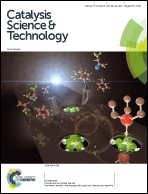Large improvement of visible-light photocatalytic H2-evolution based on cocatalyst-free Zn0.5Cd0.5S synthesized through a two-step process†
Abstract
Final metal sulfides Zn0.5Cd0.5S (ZnCdS-CH) are synthesized through a coprecipitation process followed by hydrothermal treatment. The morphological, structural and optical properties have been investigated extensively via diverse analytical techniques. The ZnCdS-CH solid solution without noble metal loading is employed in photocatalytic H2 evolution under visible light irradiation (λ ≥ 420 nm) and achieves a superior activity rate of 0.971 mmol h−1, which exceeds those of coprecipitated Zn0.5Cd0.5S (ZnCdS-C) samples by more than 13 times. Moreover, in the recycle test, the ZnCdS-CH photocatalyst shows a stable photocatalytic activity for H2 evolution under long-term visible-light irradiation. Characterization analyses demonstrate that the excellent photocatalytic H2-evolution performance of the ZnCdS-CH sample arises predominantly from the two-step processing procedure of coprecipitation followed by hydrothermal treatment at 200 °C, which makes it possess a hexagonal (wurtzite) structure, good dispersity, enhanced crystallinity, an appropriate band gap, a more negative conduction band, as well as a large number of surface defect states. This finding is of great significance for designing a facile, reproducible and inexpensive method to realise the potential of ZnxCd1−xS ternary metal sulfides in the field of H2 evolution by water splitting.



 Please wait while we load your content...
Please wait while we load your content...